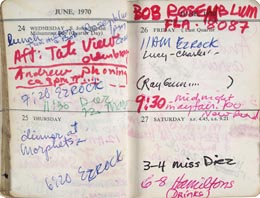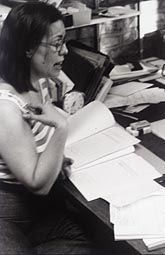The 1960s and 1970s were a radical period of art history in which the art world was revolutionised by artists who rejected the market driven art scene of the previous decades.
They began to make art that was not easily saleable, by creating work that was not object based but instead emphasised ideas and thought processes.
Sculptures and paintings were stripped down to basic structures, with simplicity favoured over technical skill or craftsmanship.
Their aim was to re-empower the artist, and lessen the power of those who controlled the art scene through the commodification of art, such as gallerists and collectors.
It resulted in dramatic changes in the way art was made, what it looked like, and how it was exhibited.

Page from Barbara Reise's diary, June 1970
© Tate Archive 2003 |
This artistic revolution reflected to some extent what was happening in the wider society.
Protests surrounding civil rights, feminism, and the Vietnam War for example, reflected increasing public dissatisfaction with society and the way governments operated.
It was in this climate that Barbara Reise, a young American art historian arrived in London.
Using Barbara as our guide, this Archive Journey takes a closer look - at the art scene, the key artists and Barbara's own place in this fascinating decade of twentieth-century
artistic innovation. |
|

Barbara Reise at her desk,
c. 1973
© Tate Archive 2003 |
